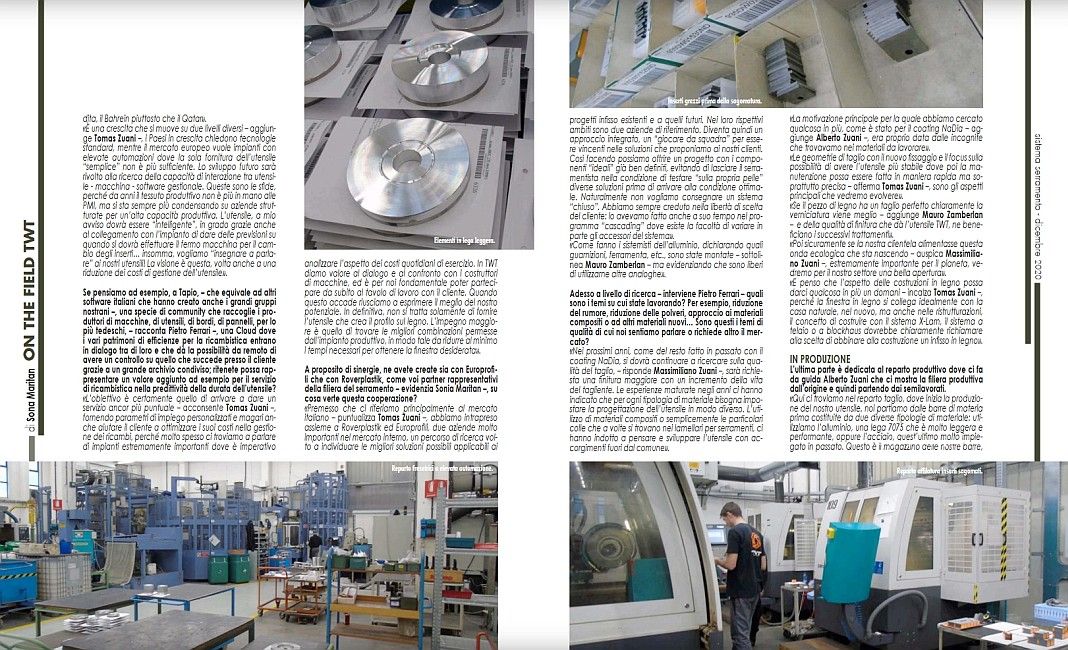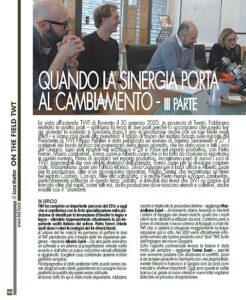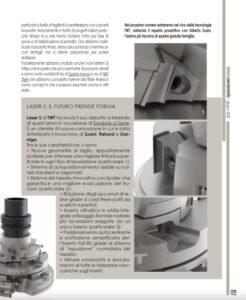Third appointment with the special that “Sistema Serramento” has dedicated to TWT
by Sonia Maritan
We are publishing the visit to TWT in Rovereto on 30 January 2020, in the province of Trento, in four separate parts – we are splitting the third into two parts because we realized that this long day spent on the company’s premises ends, after the visit to the production area, with a final tour of the offices –and so we have arrived at the penultimate part: the morning’s work table focused on the answers of TWT President Filippo Pellitteri was published in the 27th issue of Sistema Serramento.
The items on the agenda of the technical work table in the afternoon of the same day, that spoke for all of the Group’s shareholders, were published in the 28th issue, while the tour of the production department together with Pietro Ferrari, Mauro Zamberlan, Tomas Zuani and Alberto Zuani who acted as our guide is published in this issue.
Before moving on to the production department, we meet again with the TWT shareholders who are in charge of the various strategic departments of the company: Tomas Zuani for the sales division, Massimiliano Zuani for the engineering department, Silvia Galvagni for the back office and Alberto Zuani for production, as well as with a very young operator, Filippo Senter, who we meet at the end of the tour of the Coating department.
The group, along with myself, also includes Pietro Ferrari and Mauro Zamberlan, both especially interested in this third ‘salon’ and stimulated by the trends that TWT knowingly captures from the market, as well as thrilled, as we all are, with the production where tools and cutters are forged and some even coated in ‘diamond’.
IN THE OFFICE
TWT has come a long way since 2016, featuring the significant specialisation in the production of tools for machining wooden and wood-aluminium windows, to the point of becoming the leading manufacturer in this sector in Italy. Pietro Ferrari asks what the technological values of each one of the three brands are.

“The union of the three brands has allowed us to lay the foundation for TWT by taking only the best of each one of the three companies – Alberto Zuani answers. On the one side we had highly evolved software and tool designing systems, and on the other a reliable and upgraded pool of machine tools. The choice of what was to be combined was fairly simple. More complex was doing all this without creating problems for our clients, while continuing to deliver supplies and especially the quality they were used to”.
“The work we have done up to now has been very important. We have created and improved internal procedures – Massimiliano Zuani adds.At the moment we are keeping alive all of the fastening systems of the various brands, the ones our clients have been using for years. It is our intention, however, to introduce a new TWT brand fastening system, however, that will help us further progress with the reorganisation we are undergoing.
In 2020 we will officially roll out the first product with the TWT’s ‘DNA’, the result of the work of the new Group!”.
“Commercially speaking, instead, the merger proved to be very simple – says Tomas Zuani – because we didn’t have positions that entered in conflict one with the other. Zuani has always been present in Germany with its own branch, while Rekord has worked in France and in Spainwith commercial agreements and important structures. Today these are solid foundations on which, by means of the new tools and new doors and windows, we intend to relaunch a process of expansion”.
Today this allows you to offer more on the market, to raise the bar in terms of technology – Pietro Ferrari confirms –via the research of new products that at this point are already branded as TWT with their specificities. We ask them whether they are going in this direction and what are the frontiers of their research.
“We must move on two parallel tracks– Massimiliano Zuani answers – on the one side our actual production, namely tools, in which we plan to be increasingly active, while on the other there’s the research work in the field of windows and doors. In many countries it is very important to assist clients in the search for new solutions, taking into account their specific needs but without ever losing the drive to innovate. This is certainly one of TWT’s distinctive traits”.
“In certain countries, in fact, TWT is considered a designer and distributor, similarly to what occurs in the aluminium doors and windows sector”, Mauro Zamberlan adds.
You supply such an in-depth consulting service –Sonia Maritan claims –that this leads you to create a prototype of doors and windows to further analyse the specific technology!

“True. Many of our projects stem from research and development after going through laboratory testing, of course – Tomas Zuani adds. By working in this fashion we have been able to provide a complementary kind of service, known as ‘cascading’, that provides considerable added value for our clients.
Starting from “Esperia GT”, for example, the window project featuring two frame gaskets, we progressed with “Esperia Life” with aesthetically ‘minimalist’ features and influenced by the versatility of the Newform Flex project, to finally come up with “Esperia Innova”, the wood/aluminium solution that results in a high-tech window with truly competitive production costs.
It is truly an innovative project and a great challenge for the wood/aluminium window sector because, to date, the only negative aspect was linked to production costs.”
“In certain aspects, it is the ideal window”, Mauro Zamberlan claims.
So, now – Pietro Ferrari asks – what is the state of the art in cascading: after reading and writing about it for so many years, has it become a routine procedure?
“With Zuani and Rekord over 300 cascading contracts have been signed – Tomas Zuani states – complete with production checks and all of the form-filling for CE marking suitability. It is a tool used by a large majority of medium-small companies that today are more focused on their internal management because they have finally understood that this passage is an opportunity and not an imposition.”
“The tool maker who applies this is giving his clients excellent help – Pietro Ferrari adds –and it must be taken into account since he gives the client the practically completed window and the peace of mind of having a certified product. Just like with the companies that have actually implemented the ISO standards and have seen their production revolutionised also by a positive return on costs”.

Where do you see your company in ten years’ time? – Sonia Maritan asks
“I imagine we will have grown even more in ten years’ time, increasingly more solid and increasingly more renowned internationally with our TWT brand – Silvia Galvagni answers –and even if today we talk about the European market that we have continued to develop starting with the previous managements through the contacts of the three brands, we have already started moving in countries that were previously unknown to us, such as Saudi Arabia, Bahrein and Qatar”.
“This growth is proceeding on two different levels – Tomas Zuani explains: developing countries require standard technologies, while the European market needs highly automated systems because the ‘simple’ tool supply is no longer sufficient. The direction of future development is towards the capacity for interaction among tools, machines and management software.
These are today’s challenges, because for many years now the production industry has no longer been in the hands of the small and medium enterprises but rather is gravitating towards enterprises structured to sustain large production volumes.
In my opinion, the tool must become ‘intelligent’ and capable, also via its connection to the system, of forecasting when machine downtime is required to change the inserts… in short, we want to ‘teach our tools to talk’! This is our vision, contemporarily aimed at reducing tool management costs”.
If one considers Tapio, for example – similar to other Italian software products also created by large Italian groups -, a kind of community that brings together manufacturers of machines, tools, edges, panels, and mostly German, – Pietro Ferrari explains – a Cloud where the various baggages of spare parts-related efficiency can dialogue one with the other and that allows to check remotely what is happening at the client’s premises thanks to a large shared archive, do you believe it could be an added value, for instance, for the spare parts service in predicting the life of the tool?
“The goal is certainly to achieve an even more precise kind of service – Tomas Zuani admits –by providing customisable user parameters and even helping clients optimise their spare parts management costs, because quite often we find ourselves talking about extremely important manufacturing plants where the analysis of daily operating costs is a key factor. In TWT we value the dialogue and the exchange of ideas with machine manufacturers.
We think it is fundamental to start immediately working alongside the client, and when this happens we always express our potential to the fullest. After all, just supplying the tool that will create the wooden profile is not enough. The most important part of our job is to find the best combinations allowed by the production system so as to reduce the production times for that specific window to a minimum”.

Talking about synergies, you have created partnerships with Europrofili and with Roverplastik, making them representative partners of the door and window production chain –Sonia Maritan points out –What is this cooperation based on?
“Given that we are talking mainly about the Italian market – Tomas Zuani states – with Roverplastik and Europrofili, two major companies in the domestic market, we have started a research project aimed at finding the best solutions possible to be applied to existing as well as to future door and window projects. They are two companies of reference in their respective fields. This is a ‘team play’ aimed at succeeding with the solutions we offer our clients.
In this way we can offer a project with ‘ideal’ and well-defined components without leaving the door and window installer in the condition of having to ‘test firsthand’ various solutions before finding the best one. We obviously don’t aim at supplying a ‘closed’ system. We have always believed in the client’s freedom of choice, something we had already done with the ‘cascading’ program featuring the freedom of changing some of the system’s accessories”.
“Just like aluminium system manufacturers do, when they declare which gaskets, hardware, etc. has been installed – Mauro Zamberlan adds –but stating that they are entitled to use other similar components”.
At research level – Pietro Ferrari asks – on which aspects are you working now? Noise reduction, dust abatement, approach to composite materials or other new materials, for example… Are these the quality topics we hear about, or does the market seek other elements?

“In the near future, as we have done in the past with the NaDia coating, we will have to continue improving cutting quality – Massimiliano Zuani answers. The market will require greater finishing properties with a longer cutter life. The experience gained over the years indicates that for every type of material it is necessary to set up the tool’s design in a different way.
The use of composite materials, or more simply of the special adhesives that sometimes are found in the glulams used for doors and windows, have led us to design and develop tools with unusual features”.
“The main reason that made us look beyond, as we did with the NaDia coating – Alberto Zuani adds – is the unknown materials we kept on finding in the materials to be machined”.
“The cutting geometries with the new fastening system and the focus on being able to have a more stable tool, for which maintenance could be faster and especially more precise – Tomas Zuani explains -are precisely the main aspects we will see progress being made on”.
“If the piece of wood has a perfect cut, the paint coating will come out better, obviously – Mauro Zamberlan adds – and the quality of the finish provided by the TWT tool benefits all of the subsequent treatments”.
“Another thing we would like to see is our clientele riding this rising wave of environmental protection – Massimiliano Zuani hopes – that is extremely important for the planet, and it would be a good opening for our sector”.
“I also believe that the timber building sector could develop considerably in the near future – Tomas Zuani adds – because ideally speaking the wooden window is perfect for the new natural wood houses as well as for renovations where the concept of the X-Lam system, the frame or blockhaus system, would clearly require the choice of wooden windows for that building”.








